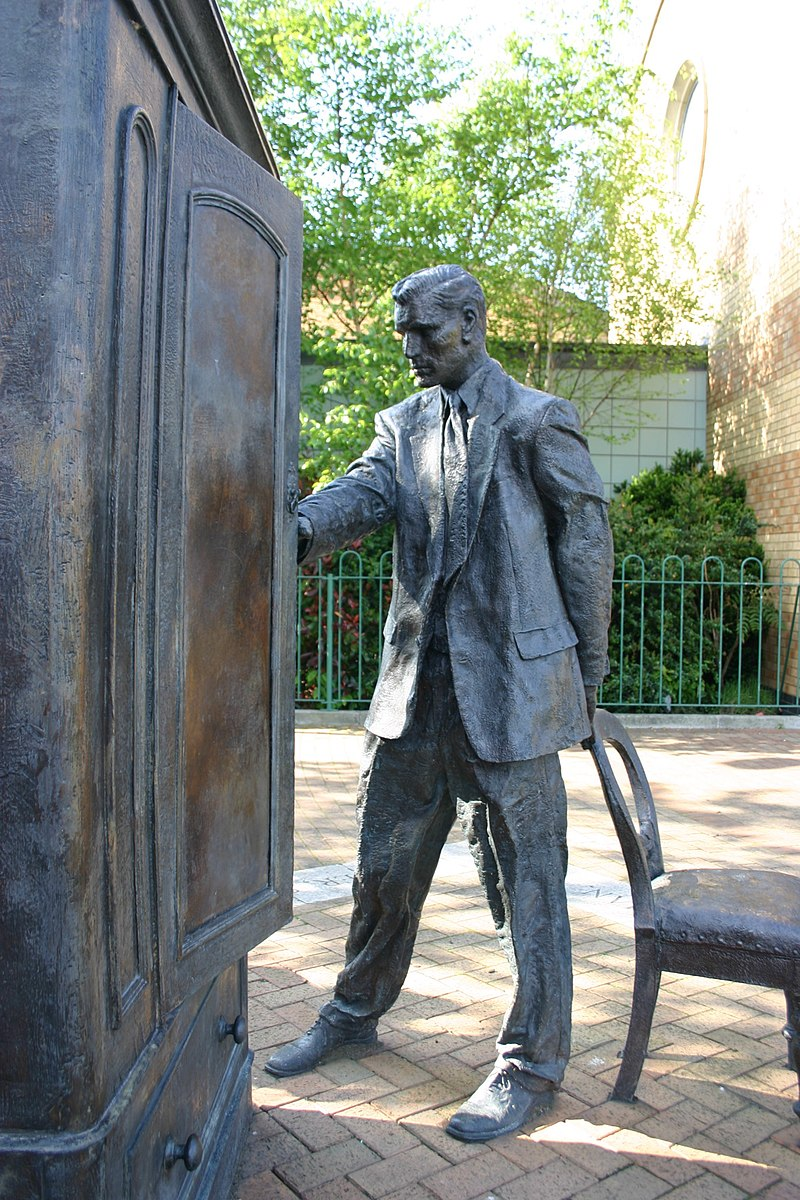
Belfast, statue of C. S. Lewis looking into a wardrobe. Entitled The Searcher by Ross Wilson. Retrieved from Wikipedia (accessed: May 4, 2022), CC BY 2.0.
Clive Staples (C.S.) Lewis
, 1898 - 1963
Clive Staples Lewis was born in 1898 in Belfast, Ireland, the younger son of Albert Lewis, a soliciter, and Florence Lewis, a graduate of the Royal University of Ireland. In the Lewis household reading and education were considered of great importance and Lewis and his older brother Warren ‘Warnie’ (later a historian) were avid readers. Lewis loved tales about animals and was influenced by Beatrix Potter’s books which encouraged him to write and illustrate his own. After his mother’s death in 1908 Lewis attended several different schools in England and Belfast. During this time, Lewis became an atheist, abandoning his Christian faith and pursuing an interest in Norse mythology. As a teenager, became fascinated by ancient Scandinavian songs and legends preserved in the Icelandic sagas. Lewis was also influenced by his father’s old tutor and former headmaster of Lurgan College, William T. Kirkpatrick, who instilled in him a love of Greek literature and mythology.
In 1917 Lewis entered Oxford and studied at University College. That year he joined the Officers’ Training Corps, at the university, and was drafted into a Cadet Battalion for training. He was commissioned into the British Army as a Second Lieutenant and shipped to France where on his19th birthday he fought in the front line, in the trenches at the Somme Valley. Following an incident in April of 1918, which Lewis was wounded, and two of his colleagues were killed by a shell, he was demobilized (in December of that year). He wrote in a letter that the horror of his wartime experiences were the basis of his pessimism and continuing atheism.
In 1920, Lewis returned to his studies at Oxford University, where he studied Greek and Latin Literature, Philosophy and Ancient History, and English. He achieved Firsts in all these subjects, and went on to tutor in Philosophy at University College. In 1925 he was appointed as a Fellow and Tutor in English Literature at Magdalen College, where he worked until 1954.
At Oxford, Lewis and J.R.R Tolkien, the Anglo-Saxon scholar, and writer of The Hobbit and The Lord of the Rings were close friends. They were active in the informal Oxford literary group known as the Inklings, a group of scholars and storytellers interested in the writing of fantasy, and which included Roger Lancelyn-Green, the biographer and reteller of mythology for children.
Lewis eventually returned to Christianity due Tolkien’s influence. He describes these changes in his autobiography Surprised by Joy which is an account of his spiritual and intellectual life through the 30s. He became known as one of the foremost British writers of Christian thought which he explored in his scholarship, and fiction. Lewis’s first scholarly book was The Allegory of Love: A Study in Medieval Tradition (1936), an exploration of the treatment of love in Medieval and Renaissance English. Later he wrote A Preface to Paradise Lost (1942). Both are still cited today. He was commissioned to write English Literature in the Sixteenth Century (Excluding Drama), for the Oxford History of English Literature (1954).
In 1956 he was appointed to the Chair of Medieval and Renaissance Literature, at Magdalene College, Cambridge University, where he worked until he died in 1963. In 1957, he married his friend Joy Davidson, an American divorcee, in a civil ceremony, in order to help her remain in the United Kingdom. Later, after she was diagnosed with bone cancer, their relationship developed and they had a Christian marriage. Davidson died in 1960 and Lewis wrote about this time of his life in A Grief Observed (1961) which was published under a pseudonym. His final book, Letters to Malcolm, was published in 1963, the same year in which he retired from his position at Cambridge. He died in November of 1963, following a period of ill health.
Lewis’ writing covers many fields: he wrote important literary criticism such as The Discarded Image: An Introduction to Medieval and Renaissance Literature (1964), and The Allegory of Love (1936). He wrote works of personal reflection and novels for adults and children. Among his novels for adults, Till We Have Faces: A Myth Retold (1956) recasts the story of Cupid and Psyche from the point of view of her older sister, Orual. In general terms, Lewis’ best known works are the seven children’s books about the fantasy world of Narnia: The Lion, the Witch and the Wardrobe (1950), Prince Caspian (1951), The Voyage of the Dawn Treader (1952), The Silver Chair (1953), The Horse and His Boy (1954), The Magician’s Nephew (1955), and The Last Battle (1956). These books reveal a fantasy world and include talking animals, mythical beasts, magic, and epic action as well as children from our (real) world, and cast the main drama of the series as a battle between good and evil in the context of the world of Narnia. Aslan, a noble lion, who can be identified as an allegory for the Son of God, brings unity to Narnia (the exception is The Horse and His Boy, which provides the prehistory of Narnia). The Narnia books have been translated into 47 languages and sold worldwide.
Sources:
Britannica (accessed: May 7, 2021),
Wikipedia (accessed: May 18, 2021).
Bio prepared by Beverley Beddoes-Mills, University of New England, bbeddoes@myune.edu.au
Records in database:
- Prince Caspian (The Chronicles of Narnia, 2)
- The Last Battle (The Chronicles of Narnia, 7)
- The Lion, the Witch, and the Wardrobe (The Chronicles of Narnia, 1)
- The Magician's Nephew (The Chronicles of Narnia, 6)
- The Silver Chair (The Chronicles of Narnia, 4)
- The Voyage of the Dawn Treader (The Chronicles of Narnia, 3)


